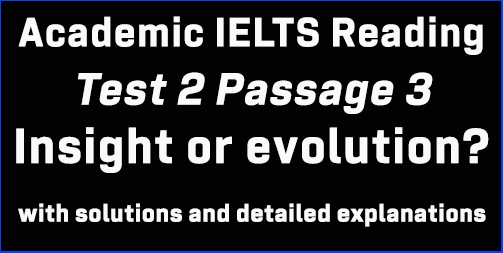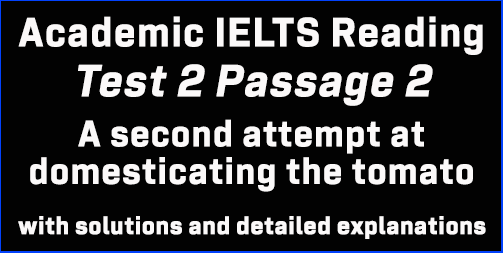IELTS Academic Reading: Cambridge 2 Test 4 Reading passage 2; No Title; with best solutions and best explanations
This Academic IELTS Reading post focuses on solutions to IELTS Cambridge 2 Reading Test 4 Reading Passage 2 which contains no title and it is about the harm that picture books can cause. This is a targeted post for IELTS candidates who have big problems finding out and understanding Reading Answers in the AC module. This post can guide you to the best to understand every Reading answer without much trouble. Finding out IELTS Reading answers is a steady process, and this post will assist you in this respect.
IELTS Cambridge 2 Test 4: AC Reading Module
Reading Passage 2: Questions 14-26
The passage contains no title
Questions 14-17: Multiple choice questions
[This type of question asks you to choose a suitable answer from the options using the knowledge you gained from the passage. Generally, this question is set found as the last question set in most passages so you should not worry much about it. Finding all the answers for previous questions gives you a good idea about these questions.]
Question no. 14: Readers are said to ‘bark’ at a text when –
Keywords for the question: readers, said to ‘bark’, at a text, when,
Take a look at lines 3-4 of paragraph D. The writer says here, “ . .. . .. . Even if a child is able to read aloud fluently, he or she may not be able to understand much of it: this is called ‘barking at text’.. .. .. .”
Here, he or she may not be able to understand much of it = they have difficulty assessing its meaning,
So, the answer is: D (they have difficulty assessing its meaning)
Question no. 15: The text suggests that –
Keywords for the question: text, suggests,
The answer can be found in paragraph C. Here, take a look at these lines, “ … . . On the contrary, a great deal of empirical evidence shows that pictures interfere in a damaging way with all aspects of learning to read. .. .. . .”
Here, pictures interfere in a damaging way with all aspects of learning to read = pictures can slow down reading answers,
So, the answer is: B (pictures can slow down reading progress)
Question no. 16: University academics are concerned because –
Keywords for the question: university academics, concerned, because,
Have a close look at the final lines of paragraph F, “ . .. . . The response of educators has been to extend the use of pictures in books and to simplify the language, even at senior levels. The Universities of Oxford and Cambridge recently held joint conferences to discuss the noticeably rapid decline in literacy among their undergraduates.”
Here, educators = university academics,
These lines suggest that educators or university academics think that academic books noticeably rapid decline in literacy, or, there has been a significant change in student literacy.
So, the answer is: C (there has been a significant change in student literacy)
Question no. 17: The youngest readers will quickly develop good reading skills if they –
Keywords for the question: youngest readers, will quickly develop, good reading skills, if,
The answer can be traced in paragraph E where the writer states, “ . .. . Looking at a picture actively prevents children younger than nine from creating a mental image, and can make it difficult for older children. In order to learn how to comprehend, they need to practise making their own meaning in response to text. They need to have their innate powers of imagination trained.”
Here, children younger than nine = the youngest readers,
need to practise making their own meaning in response to text = learn the art of telling stories,
So, the answer is: D (learn the art of telling stories)
Questions 18-21: YES, NO, NOT GIVEN
In this type of question, candidates are asked to find out whether:
The statement in the question matches with the claim of the writer in the text- YES
The statement in the question contradicts with the claim of the writer in the text- NO
The statement in the question has no clear connection with the account in the text- NOT GIVEN
[TIPS: For this type of question, you can divide each statement into three independent pieces and make your way through with the answer.]
Question no. 18: It is traditionally accepted that children’s books should contain few pictures.
Keywords for the question: traditionally accepted, children’s books, should contain, few pictures,
In paragraph B, lines 3-4 say, “ . .. . . When teachers use picture books, they are simply continuing a long-established tradition that is accepted without question. . .. ..”
Here, long-established tradition = it is traditionally accepted,
The lines suggest that it is traditionally accepted that children’s books should contain a lot of pictures; NOT few pictures.
So, the answer is: NO
Question no. 19: Teachers aim to teach both word recognition and word meaning.
Keywords for the question: teachers, aim to teach, both, word recognition, word meaning,
The answer lies in the first few lines of paragraph D, where the writer says, “A teacher’s main concern is to help young beginner readers to develop not only the ability to recognise words, but the skills necessary to understand what these words mean. .. .. …”
Here, A teacher’s main concern = teachers aim to, help young beginner readers = teach, recognise words = word recognition, what these words mean = word meaning,
So, the answer is: YES
Question no. 20: Older readers are having difficulty in adjusting to texts without pictures.
Keywords for the question: older readers, having difficulty, adjusting to texts, without pictures,
Paragraph E has the answer to this question. The writer says here, in lines 4-6, “ . .. . Looking at a picture actively prevents children younger than nine from creating a mental image, and can make it difficult for older children. .. .. .. .”
Here, older children = older readers, make it difficult = having difficulty in adjusting to texts without pictures,
So, the answer is: YES
Question no. 21: Literacy has improved as a result of recent academic conferences.
Keywords for the question: literacy, improved, as a result of, recent academic conferences,
We find about a conference at the end of paragraph F, “ . .. .. The Universities of Oxford and Cambridge recently held joint conferences to discuss the noticeably rapid decline in literacy among their undergraduates.”
However, there is NO INFORMATION on whether literacy has improved as a result of recent academic conferences.
So, the answer is: NOT GIVEN
Questions 22-25: Identifying information
[This question asks you to find information from the passage and write the number of the paragraph (A, B, C or D … .. ) in the answer sheet. Now, if the question is given in the very first part of the question set, I’d request you not to answer them. It’s mainly because this question will not follow any sequence, and so it will surely kill your time. Rather, you should answer all the other questions first. And just like List of Headings, only read the first two lines or last two lines of the expected paragraph initially. If you find the answers, you need not read the middle part. If you don’t find answers yet, you can skim the middle part of the paragraph. Keywords will be a useful matter here.]
Question no. 22: The decline of literacy is seen in groups of differing ages and abilities.
Keywords for the question: decline of literacy, seen, groups of differing ages and abilities,
Paragraph F has the answer to this question. The writer says here, in lines 6-7, “ . .. . The least intelligent are most vulnerable, but tests show that even intelligent children are being affected. .. .. .”
Here, the least intelligent & intelligent children = groups of different ages and abilities,
most vulnerable & being affected = decline of literacy,
So, the answer is: F
Question no. 23: Reading methods currently in use go against research findings.
Keywords for the question: reading methods, currently in use, go against, research findings,
In paragraph C, take a look at the beginning, “Amazingly, there is virtually no empirical evidence to support the use of illustrations in teaching reading. On the contrary, a great deal of empirical evidence shows that pictures interfere in a damaging way with all aspects of learning to read. .. .. .”
Here, the lines suggest that current reading methods go against (on the contrary) research findings.
So, the answer is: C
Question no. 24: Readers able to ignore pictures are claimed to make greater progress.
Keywords for the question: readers, able to ignore pictures, claimed to make, greater progress,
In paragraph J, have a look at the beginning, where the writer says, “ . .. .. . poor readers given no pictures learnt significantly more words than those learning to read with books with pictures. .. .. .”
Here, given no pictures = ignore pictures, learnt significantly more words = claimed to make greater progress,
So, the answer is: J
Question no. 25: Illustrations in books can give misleading information about word meaning.
Keywords for the question: illustrations in books, can give, misleading information, word meaning,
The final lines of paragraph I say, “ . .. . . they may well be misled by aspects of the pictures which are not closely related to the meaning of the word they are trying to understand.”
Here, misled by aspects of the pictures = Illustrations in books can give misleading information, not closely related to the meaning of the word they are trying to understand = word meaning,
So, the answer is: I
Question no. 26: Multiple choice questions (Identifying the main purpose/aim/title of the passage)
[This type of question asks you to choose a suitable answer from the options that shows the main aim/purpose/title using the knowledge you gained from the passage. Generally, this question is found as the last question so you should not worry much about it. Finding all the answers for previous questions gives you a good idea about the title.]
From the list below choose the most suitable title for the whole of Reading Passage 2.
Keywords for the question: most suitable title,
Our understanding of the passage by answering all the questions (14-25) is that pictures used in books cause harm.
So, the answer is: C (The harm that picture books can cause)
Click here for solutions to Cambridge 2 AC Test 4 Reading Passage 1
Click here for solutions to Cambridge 2 AC Test 4 Reading Passage 3




Hi. The book itself has chosen D for 16 and C for 17 … I think you’ve made a mistake….
Sorry! There was a mistake and I’ve just fixed that!